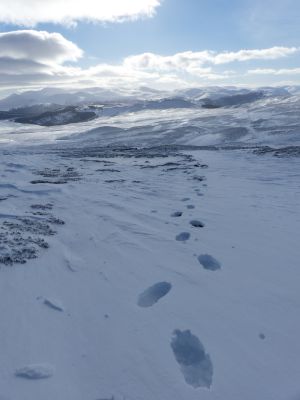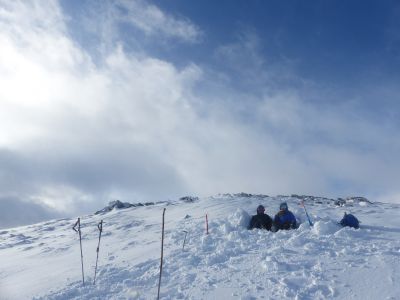Walking in the Cairngorms National Park in the winter can be a magical ex perience; the colours, the light, the crisp, glistening snow on the mountains. It’s so inviting, and can be such an amazing experience. But walking in the winter hills does need a lot of preparation, skill and equipment to ensure you stay safe.
perience; the colours, the light, the crisp, glistening snow on the mountains. It’s so inviting, and can be such an amazing experience. But walking in the winter hills does need a lot of preparation, skill and equipment to ensure you stay safe.
Don’t underestimate how fast the conditions can change in winter it may be bright blue sky when you set off, but conditions can change in a split second, ensure you have appropriate warm clothing, layers, socks, boots, gloves and hats, and a really indispensable piece of kit is some goggles. As well as warmth, you’ll need a good outer shell. Down jackets are amazing, but in rain they can become heavy and cold. The guys at
Braemar Mountain Sports are fantastic and can help with everything you need.
Navigation is key. Ensure you are familiar with using an OS map and compass. GPS are a fantastic piece of kit but should be an additional piece of kit, not your soul piece of kit to rely on your walk. Mobile phones are also a fantastic addition to your kit list, but in the hills there may not be signal, your battery can drain fast, and if it’s all you are using to navigate you can be left lost. You can learn about Navigation by attending a course such as this
one run by CN-Do Scotland or
Glenmore Lodge.
Be avalanche aware. Avalanches are very complicated entities which are dynamic and the conditions can change quickly. Avalanches can happen at any time, but it is a really good idea to become familiar with the S
cottish Avalanche Information Service and also attend a winter skills course to get familiar with planning your walks depending on the conditions you are faced with.

Check the weather forecast. You might book a holiday in the hills weeks in advance with the aim of walking 12 munros, but weather conditions can scupper your plans. Always be prepared to change your plans if the weather poses a threat. It’s always better to turn back and return in the future than risk getting in to difficulty.
Leave a route card. It’s a good idea to leave a route card with someone detailing your route, when you set off, when you expect to return, and contact numbers.
Daylight is limited so be realistic about how much time you have available for your walk. And always carry a torch and spare batteries in your bag.
Using crampons and an ice axe. The snow may be fluffy and bright at the start of your walk, but up on the hills it can be sheet ice, and without an ice axe and crampons, may be completely inaccessible. You will need good winter boots to fit your crampons on, and also have knowledge on how to use your ice axe and crampons. It’s a brilliant idea to attend a winter skills course, such as one run by
McDougall Mountaineering or
The Mountaineering Council of Scotland.
Don’t forget your camera and have fun.
